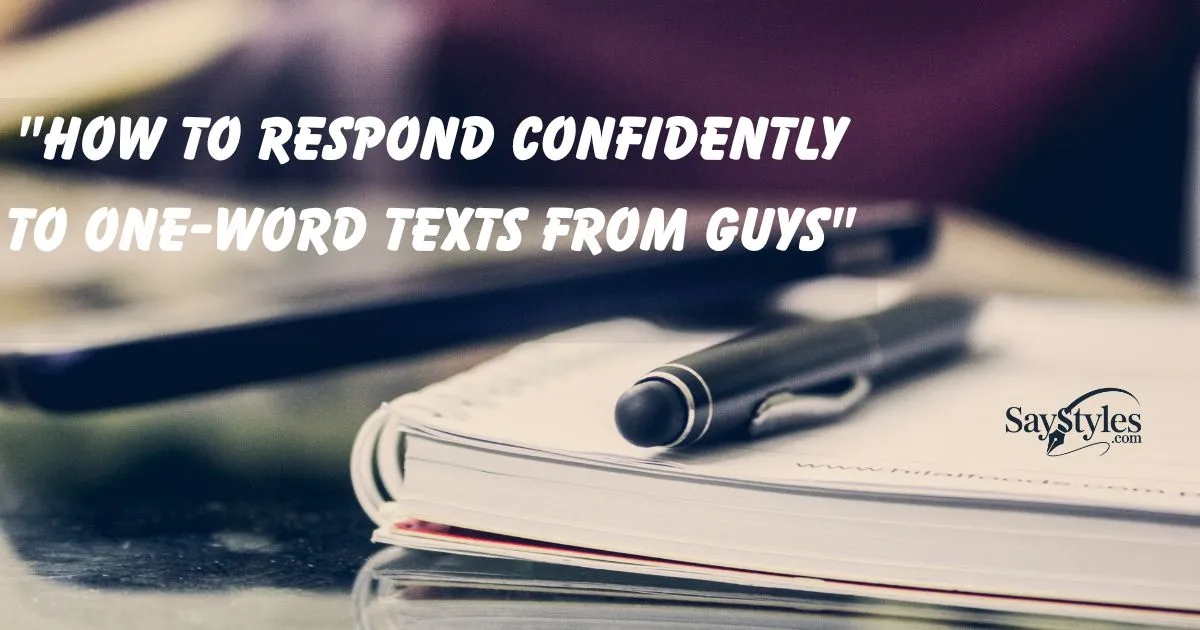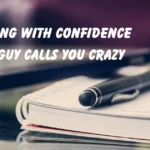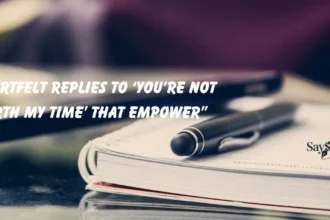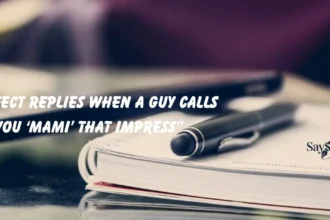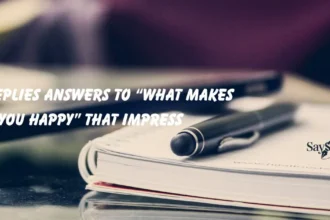A one-word text can speak volumes or say nothing at all. When you’re receiving these short replies, it’s easy to feel puzzled. Is it a sign of boredom, a lack of interest, or just a habit of texting? Sometimes, it’s just part of a casual conversation, but other times, it can bring uncertainty about what to say next.
As a writer, I get it no one wants to end the chat too soon or struggle to keep things flowing. That’s why I created this blog post as a guide to help you respond to short messages in a way that keeps the conversation engaging and meaningful.
In this article, you’ll discover smart ways to handle one-word texts, turn them into interesting discussions, and keep the chat alive!
Understanding One-Word Texts
Understanding One-Word Texts is key to knowing what the sender really means. A one-word text can be a simple reply, a lack of effort, or even a way to test your interest. Sometimes, it’s just part of a casual conversation, while other times, it might signal uncertainty or disinterest. The key is to look at the context—how the person usually texts, their mood, and the situation. Instead of feeling puzzled or assuming the worst, try to respond in a way that keeps the conversation engaging and meaningful.
1. Reply with a Question
Story: Emma receives a one-word text Yeah from Jake after asking if he wants to hang out. She feels unsure about his interest.
When to Use: This works best when you want to keep the conversation going and get a clearer response.
When Not to Use: Avoid this if the person consistently gives one-word replies, showing disinterest.
Example:
Emma: Do you want to watch a movie later?
Jake: Yeah
Emma: Which one are you in the mood for? Action or comedy?
How to Respond 🗣️ Ask open-ended questions like What do you think? or How was your day? to encourage more engagement.
2. Share More Information
Story: Mike texts Lily a simple Okay after she suggests trying a new restaurant. She wants to make the conversation more interesting.
When to Use: Ideal when you want to provide more context or details to make the chat engaging.
When Not to Use: Not helpful if the person is clearly uninterested or in a hurry.
Example:
Lily: Let’s try that new Italian place!
Mike: Okay
Lily: I heard they have the best pasta in town! Do you like Alfredo sauce?
How to Respond 🗣️ Add extra details to spark interest and encourage a fuller response.
3. Playful Response

Story: Sarah asks Tom if he finished his project, and he replies with Nope. She decides to keep things lighthearted.
When to Use: Best when you want to add fun to the conversation and keep it casual.
When Not to Use: Avoid if the situation is serious or requires a thoughtful response.
Example:
Sarah: Did you finish your project?
Tom: Nope
Sarah: Uh-oh, should I start writing your apology email to the boss now?
How to Respond 🗣️ Use humor to turn a dull reply into a fun exchange.
4. Express Curiosity
Story: Alex gets a one-word text Fine from Mia when asking about her day. He wants to show he cares.
When to Use: Useful when someone seems upset or reserved, and you want to learn more.
When Not to Use: Not needed if the person is in a rush or clearly not in the mood to talk.
Example:
Alex: Hey, how was your day?
Mia: Fine
Alex: Just fine? Something on your mind?
How to Respond 🗣️ Ask gentle follow-up questions like Tell me more or What made your day fine?
5. Be Direct
Story: Rachel texts David Hey and he responds with Hi. She wants to know if he’s interested in talking.
When to Use: When you want to address the situation directly and avoid unnecessary guessing.
When Not to Use: Avoid if you don’t want to risk making the conversation feel forced.
Example:
Rachel: Hey
David: Hi
Rachel: Are you busy? If not, let’s chat!
How to Respond 🗣️ Be upfront and ask, Are you up for a conversation? or Should we talk later?
Responding with Confidence When a Guy Calls You Crazy
6. Share Your Thoughts
Story: Jason asks Emily if she likes his new haircut, and she replies with Nice. He wants a deeper chat.
When to Use: When you want to encourage someone to share more of their opinion.
When Not to Use: If the topic doesn’t require much discussion.
Example:
Jason: Got a new haircut! What do you think?
Emily: Nice
Jason: Thanks! I was debating between this and a shorter style.
How to Respond 🗣️ Add your own opinion or thoughts to expand the conversation.
7. Light Humor
Story: Olivia texts Mark What’s up? and he replies with Nothing. She decides to make it fun.
When to Use: Great for making a conversation lively and interesting.
When Not to Use: If the other person seems upset or uninterested in joking.
Example:
Olivia: What’s up?
Mark: Nothing
Olivia: Wow, ‘nothing’ sounds so thrilling. Is it a new hobby?
How to Respond 🗣️ Use lighthearted jokes or playful sarcasm to keep things fun.
8. Show Enthusiasm
Story: Kevin gets a text from Anna saying Sure after he invites her to a party. He wants to make her more excited.
When to Use: When you want to boost engagement and excitement.
When Not to Use: Avoid if the person doesn’t seem interested in the topic.
Example:
Kevin: Want to come to the party?
Anna: Sure
Kevin: Awesome! It’s going to be so much fun. Can’t wait to see you there!
How to Respond 🗣️ Use excitement to make conversations more dynamic.
9. Offer a Suggestion

Story: Sam texts Mia Maybe when she asks if he wants to go hiking. She wants a clearer answer.
When to Use: When you want to help the person decide or show interest.
When Not to Use: If they already gave a definite answer.
Example:
Mia: Want to go hiking?
Sam: Maybe
Mia: How about Saturday morning? The weather looks great!
How to Respond 🗣️ Suggest a specific plan or idea to move the conversation forward.
10. Give a Compliment
Story: Josh tells Lily Cool after she shares a picture of her artwork. She wants a more engaging chat.
When to Use: When you want to add warmth to a conversation.
When Not to Use: If the person is not open to compliments.
Example:
Lily: Here’s my latest painting!
Josh: Cool
Lily: Thanks! I worked really hard on it. What do you like most about it?
How to Respond 🗣️ Compliment them and ask a follow-up question to keep the chat going.
11. Acknowledge and Move On
Story: Sarah texts Jake after a long day, and he replies with just Okay. She feels unsure but doesn’t want to overthink it.
When to Use: When the one-word reply doesn’t need a response, and you don’t want to drag the conversation.
When Not to Use: If the person seems upset or the topic is important, ignoring it might seem rude.
Example:
Sarah: Hey, I hope you had a good day!
Jake: Okay.
Sarah: Got it! Talk soon 😊
How to Respond 🗣️ Keep it simple. Say something neutral like Got it or Alright, talk later. If needed, shift the conversation to something new.
12. Use a Follow-Up Question
Story: Liam and Emily are chatting, but Liam suddenly sends just Cool. Emily doesn’t want the chat to die, so she asks another question.
When to Use: When you want to keep the conversation flowing and show interest.
When Not to Use: If the person consistently gives short replies, they might not want to chat.
Example:
Emily: I finally tried that new restaurant!
Liam: Cool.
Emily: Yeah, the pasta was amazing! Have you been there before?
How to Respond 🗣️ Show curiosity. Ask about their thoughts, plans, or experiences. A good response can be, Have you ever tried it? or What’s your favorite place to eat?
13. Offer a Friendly Gesture
Story: Mia and Alex are texting, and Alex just says Thanks. Instead of letting the chat end, Mia adds a warm touch.
When to Use: When you want to keep things positive without forcing a long conversation.
When Not to Use: If the person seems uninterested or busy, pushing the chat might feel unnecessary.
Example:
Mia: Hope that helped!
Alex: Thanks.
Mia: Anytime! Hope your day is going well 😊
How to Respond 🗣️ A friendly comment like No problem! or Glad to help! keeps the conversation open. Adding a positive emoji can also make the message feel warmer.
14. Discuss a Common Interest
Story: Noah and Sophie are in a group chat, but when Noah messages Sophie privately, he only says Yeah. Instead of stopping there, Sophie brings up something they both like.
When to Use: When you know the person shares a hobby or interest with you and need a better way to engage.
When Not to Use: If the person is clearly not interested in talking at the moment.
Example:
Sophie: Did you see the new trailer?
Noah: Yeah.
Sophie: It looks amazing! I bet the action scenes will be wild,. What do you think?
How to Respond 🗣️ Bring up something you both enjoy. Try saying, That reminds me, did you hear about…? or I know you like this too, what are your thoughts?
15. Acknowledge and Compliment

Story: Olivia texts Daniel about his recent project, and he just replies Yep. Instead of ending the conversation, she gives him a compliment.
When to Use: When you want to make the conversation more engaging and show appreciation.
When Not to Use: If the person doesn’t seem interested in continuing the chat.
Example:
Olivia: Your painting turned out great!
Daniel: Yep.
Olivia: Seriously, you did an amazing job. You have a real talent!
How to Respond 🗣️ A simple compliment can warm up the conversation. Try saying, That was really cool! or You did great on that!
16. Suggest an Activity
Story: Jason texts Ella with a short Sure when she asks about plans. She uses this moment to suggest something fun.
When to Use: When you’re trying to make plans or encourage them to be more involved.
When Not to Use: If the person isn’t in the mood for chatting or making plans.
Example:
Ella: Want to hang out this weekend?
Jason: Sure.
Ella: Great! How about a movie night or grabbing coffee?
How to Respond 🗣️ Keep it open-ended with options like Let’s do something fun! or How about [specific activity]?
17. Share Your Feelings
Story: Rachel texts Brian, and he only replies with K. She feels a little frustrated but wants to express herself calmly.
When to Use: When their short texts make you feel ignored, and you want to communicate openly.
When Not to Use: If the situation doesn’t require an emotional response, keeping it light might be better.
Example:
Rachel: So, are we still meeting up later?
Brian: K.
Rachel: I feel like you’re not really interested. If you’re busy, just let me know.
How to Respond 🗣️ Be honest but not confrontational. You can say, I feel like you’re not into this convo or Let me know if now’s not a good time to chat.
18. Use an Emoji

Story: Kevin and Laura are chatting, but Kevin just replies with Okay. Instead of overthinking it, Laura keeps it light with an emoji.
When to Use: When you want to keep the conversation relaxed without forcing a response.
When Not to Use: If the situation is serious or requires a proper reply.
Example:
Laura: Let’s go to the park later!
Kevin: Okay.
Laura: 😊
How to Respond 🗣️ Emojis can add warmth and avoid awkward silences. Try a thumbs-up 👍, smile 😊, or even a playful 😜 to keep it casual.
19. Ask for Clarification
Story: Ben texts Ashley with just No. She isn’t sure what he means, so she asks for more details.
When to Use: When the short text is unclear, and you need more information.
When Not to Use: If it’s obvious that the person doesn’t want to continue talking.
Example:
Ashley: Did you like the new episode?
Ben: No.
Ashley: Oh no! What didn’t you like about it?
How to Respond 🗣️ Ask simple questions like What do you mean? or Can you explain a bit more?
20. Make a Light Joke
Story: Ryan texts Chloe, and she gets a one-word reply. Instead of letting it be awkward, she turns it into a joke.
When to Use: When the conversation feels dull and could use some humor.
When Not to Use: If the person is upset or having a bad day.
Example:
Chloe: How’s your day going?
Ryan: Fine.
Chloe: Wow, such enthusiasm! You must be having the best day ever! 😂
How to Respond 🗣️ Add humor with playful sarcasm or a funny reaction. Try saying, Well, that was deep! or I can feel the excitement through my screen!
Perfect Replies to ‘I Have a Crush on You’
21. Confirm Plans
Story: Emily and Jake made plans earlier, but Jake responds with just Yeah. Emily wants to make sure everything is set.
When to Use: When you need to double-check details before meeting up.
When Not to Use: If the person has already confirmed and repeating may sound annoying.
Example:
Emily: So we’re still on for 6 PM?
Jake: Yeah.
Emily: Great! Are we meeting at the usual spot?
How to Respond 🗣️ Keep it clear and direct. Say, Just confirming, we’re good for [time/place]?
22. Show Enthusiasm
Story: Lucas texts Mia a simple Nice after she shares exciting news. She wants to keep the energy up.
When to Use: When you want to make the conversation more engaging and fun.
When Not to Use: If the person seems uninterested, forcing enthusiasm might feel awkward.
Example:
Mia: I just got promoted!
Lucas: Nice.
Mia: Thanks! I’m so excited! 🎉 You’ve got to celebrate with me soon!
How to Respond 🗣️ Add energy with emojis or phrases like That’s amazing! or Wow, that’s awesome!
23. Share a Fun Fact
Story: Olivia gets a Cool reply from Ethan and decides to spice things up with something interesting.
When to Use: When the conversation is dull and could use a spark.
When Not to Use: If the other person isn’t engaging or responding much.
Example:
Olivia: Just visited the museum today!
Ethan: Cool.
Olivia: Did you know the Mona Lisa has no eyebrows? They faded over time!
How to Respond 🗣️ Add something fun like Fun fact: Did you know…? or That reminds me of…
24. Mention an Upcoming Event

Story: Brian and Rachel are chatting, but Brian just replies Okay. Rachel decides to bring up an event to keep the conversation alive.
When to Use: When you want to create excitement or invite them to something.
When Not to Use: If they seem uninterested in making plans.
Example:
Rachel: The weekend is almost here!
Brian: Okay.
Rachel: The new festival is happening Saturday! Want to check it out?
How to Respond 🗣️ Say, Did you hear about [event]? or We should go to [event]!
25. Share a Recent Experience
Story: Emma messages Noah, but his response is just K. She shifts the chat by sharing something interesting.
When to Use: When you want to keep the conversation flowing naturally.
When Not to Use: If the person clearly isn’t interested in chatting.
Example:
Emma: I finally tried that new bakery!
Noah: K.
Emma: Their croissants were amazing! You’ve got to try them!
How to Respond 🗣️ Say, Guess what happened today? or You won’t believe what I just did!
26. Give a Compliment
Story: Daniel replies Yep to Ava’s message. She uses a compliment to lighten the mood.
When to Use: When you want to make the chat more positive and engaging.
When Not to Use: If compliments don’t fit the conversation.
Example:
Ava: You played really well today!
Daniel: Yep.
Ava: Seriously, you have amazing skills! You always impress me.
How to Respond 🗣️ Say, That was really impressive! or You’re seriously talented!
27. Ask About His Day
Story: Mark sends a one-word text, and Sarah doesn’t want to let the chat die, so she asks about his day.
When to Use: When you want to show interest and keep the conversation going.
When Not to Use: If he already seems uninterested in talking.
Example:
Sarah: Hey, how was your day?
Mark: Fine.
Sarah: Anything exciting happen? Or just a regular day?
How to Respond 🗣️ Say, How’s your day been? or Anything fun happen today?
28. Comment on the Weather
Story: Jake sends a short Sure text. Lily lightens the mood with a comment about the weather.
When to Use: When you’re looking for a casual way to restart the conversation.
When Not to Use: If the weather isn’t relevant or interesting.
Example:
Lily: Looks like it might rain later!
Jake: Sure.
Lily: I love rainy days! Perfect for a movie night.
How to Respond 🗣️ Say, wild, hot today, right? or This weather is perfect for [activity]!
29. Show Support
Story: Chris replies Thanks to Emma’s message. Instead of ending the chat, she offers some encouragement.
When to Use: When you want to be supportive and uplifting.
When Not to Use: If the person doesn’t seem to need reassurance.
Example:
Emma: You did an amazing job on that project!
Chris: Thanks.
Emma: Seriously, you worked so hard. I admire your dedication!
How to Respond 🗣️ Say, You totally deserve it! or I’m really proud of you!
30. Ask About His Weekend
Story: David replies with a short Yeah when Mia texts. She changes the topic by asking about his weekend plans.
When to Use: When you want to start a natural and friendly conversation.
When Not to Use: If he already mentioned being busy or uninterested.
Example:
Mia: Any fun plans for the weekend?
David: Yeah.
Mia: Nice! What are you up to?
How to Respond 🗣️ Ask, Any fun weekend plans? or Doing anything exciting?
21. Turning a Dry Conversation into Something Fun
Story: Mia receives a simple “Okay” from Jake after she shares something interesting. She doesn’t want the conversation to dry up, so she introduces something playful.
When to Use: When the chat is becoming dull and you need to revive it with some fun.
When Not to Use: If the other person is busy or seems uninterested in playful banter.
Example:
Mia: I’m thinking about trying a new hobby this weekend!
Jake: Okay.
Mia: I’m thinking of joining a dance class! Maybe I’ll be the next TikTok sensation! 😂
How to Respond 🗣️ Say, “Ever tried [activity]?” or “What’s the silliest hobby you’ve always wanted to try?”
22. The Power of Open-Ended Questions
Story: Sarah sends a quick “Thanks” to Matt, and instead of ending the conversation, she uses an open-ended question to keep it going.
When to Use: When you want to invite a longer, more meaningful response.
When Not to Use: If the person seems uninterested in continuing the conversation.
Example:
Sarah: I just got a new book!
Matt: Thanks.
Sarah: What’s the last book you read? I’m always looking for new recommendations!
How to Respond 🗣️ Ask something like, “What’s your favorite type of music?” or “Have you ever been to [place]?”
23. Using Humor to Keep the Chat Engaging
Story: Tom replies with just “Okay” after Lily shares a funny incident. Lily decides to add some humor to keep the chat lively.
When to Use: When the person has given a one-word response, and you want to lighten the mood.
When Not to Use: If the person seems serious or in a rush.
Example:
Lily: I accidentally walked into the wrong meeting today!
Tom: Okay.
Lily: I think I made some new friends in the process! 😂
How to Respond 🗣️ Add a playful comment like, “That’s one way to network! 😂” or “Well, at least you didn’t walk into a wedding!”
24. When to Let the Conversation End Gracefully

Story: Ryan messages Emily, but she replies with just “Yep.” He realizes it’s best to step back.
When to Use: When the other person gives multiple short replies with no interest in continuing.
When Not to Use: If the person is usually chatty and might just be distracted.
Example:
Ryan: Hey, how was your day?
Emily: Fine.
Ryan: Want to chat later? I don’t want to keep you if you’re busy.
How to Respond 🗣️ Say, “I’ll catch up with you later!” or “Let me know when you’re free!”
25. How to Read Between the Lines of Short Replies
Story: Anna keeps getting “Sure” or “Maybe” from James, and she wonders what’s really going on.
When to Use: When short replies seem out of character, and you suspect something’s wrong.
When Not to Use: If the person is always brief in texting and it’s just their style.
Example:
Anna: Want to hang out this weekend?
James: Maybe.
Anna: You okay? You seem off today.
How to Respond 🗣️ Ask, “Is everything okay?” or “You don’t sound like yourself—want to talk?”
Top Editor’s Choice Responses
- Got it! Talk soon 😊
- Oh, that sounds interesting! Tell me more!
- Haha, you sound thrilled! 😂
- That’s amazing! I love that!
- Oh, I see! What do you think about [related topic]?
- No worries! Let’s chat later.
- That’s great! What else is new?
- I totally get that! Happens to me too!
- Ooh, exciting! What’s your next step?
- Haha, you must be having the time of your life! 😆
- Oh really? I had no idea! That’s cool!
- Awesome! When do you want to do it?
- I feel you! That’s totally relatable.
- That’s so funny! You always crack me up!
- Wait, seriously? That’s wild!
- Let’s make plans soon then!
- Omg, I was just thinking about that too!
- Oof, sounds rough! Hope it gets better.
- You always have the best ideas!
- That’s such a good point! I never thought of it that way!
Conclusion
In conclusion, responding to one-word texts from guys can be tricky, but it doesn’t have to be a dead end for the conversation. By using the right strategies whether it’s adding humor, asking open-ended questions, or showing interest in a common topic you can turn a brief reply into a more meaningful and engaging exchange.
Remember, the goal is to keep the conversation alive and interesting without forcing it. With the tips and examples provided, you now have a better understanding of how to handle short messages and keep things flowing smoothly. So next time you get a one-word text, use these approaches to turn it into something worth talking about!

I’m Lily Hart, the Admin behind the engaging responses at SayStyles.com! With a knack for blending wit and warmth, I turn every piece of writing into something memorable. From clever advice to fun comebacks, I’m here to make sure every response leaves you smiling and thinking.

